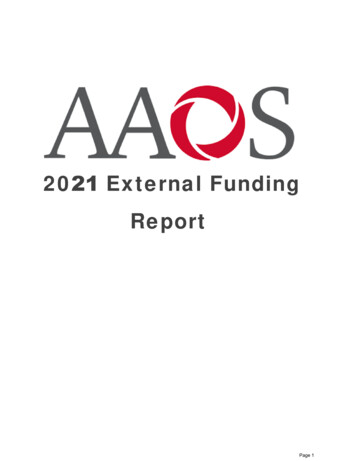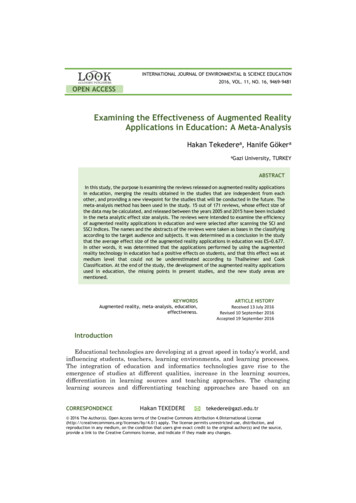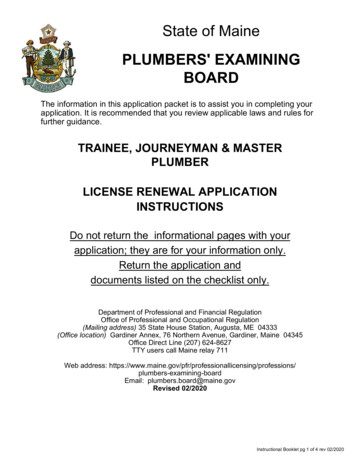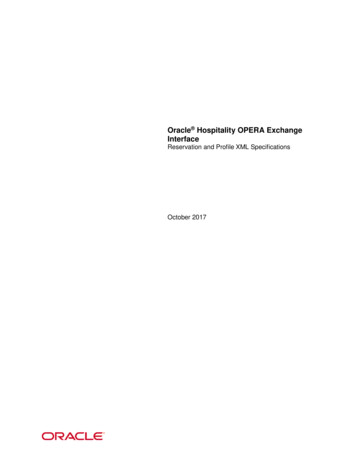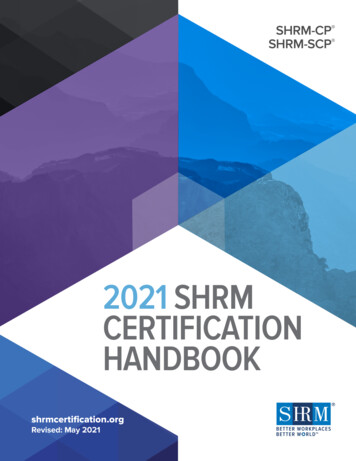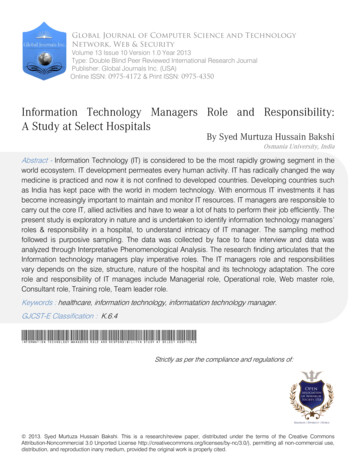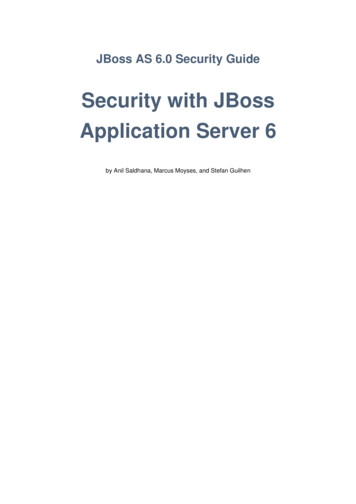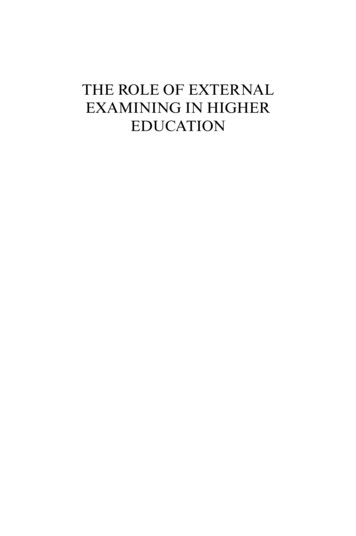
Transcription
THE ROLE OF EXTERNALEXAMINING IN HIGHEREDUCATION
INNOVATIONS IN HIGHEREDUCATION TEACHING ANDLEARNINGSenior Series Editor: Patrick Blessinger,St John’s University and Higher EducationTeaching and Learning Association, USAAssociate Series Editor: Enakshi Sengupta,Higher Education Teaching andLearning Association, USAPublished Volumes:Volume 23 University–Community Partnerships for Promoting Social Responsibility inHigher Education – Edited by Enakshi Sengupta, Patrick Blessinger and CraigMahoneyVolume 24 Leadership Strategies for Promoting Social Responsibility in Higher Education– Edited by Enakshi Sengupta, Patrick Blessinger and Craig MahoneyVolume 25 Integrating Community Service into Curriculum: International Perspectives onHumanizing Education – Edited by Enakshi Sengupta, Patrick Blessinger andMandla MakhanyaVolume 26 International Perspectives on Improving Student Engagement: Advances inLibrary Practices in Higher Education – Edited by Enakshi Sengupta, PatrickBlessinger and Milton D. CoxVolume 27 Improving Classroom Engagement and International Development Programs:International Perspectives on Humanizing Higher Education – Edited byEnakshi Sengupta, Patrick Blessinger and Mandla MakhanyaVolume 28 Cultural Competence in Higher Education – Edited by Tiffany Puckett, andNancy LindVolume 29 Designing Effective Library Learning Spaces in Higher Education – Edited byEnakshi Sengupta, Patrick Blessinger and Mandla S. MakhanyaVolume 30 Developing and Supporting Multiculturalism and Leadership Development –Edited by Enakshi Sengupta, Patrick Blessinger and Mandla S. MakhanyaVolume 31 Faculty and Student Research in Practicing Academic Freedom – Edited byEnakshi Sengupta and Patrick BlessingerVolume 32 International Perspectives on Policies, Practices & Pedagogies for PromotingSocial Responsibility in Higher Education – Edited by Enakshi Sengupta,Patrick Blessinger and Craig MahoneyVolume 33 International Perspectives on the Role of Technology in Humanizing HigherEducation – Edited by Enakshi Sengupta, Patrick Blessinger and Mandla S.MakhanyaVolume 34 Humanizing Higher Education through Innovative Approaches for Teachingand Learning – Edited by Enakshi Sengupta, Patrick Blessinger and Mandla S.MakhanyaVolume 35 Humanizing Higher Education through Innovative Approaches for Teachingand LearningVolume 36 Integrating Research-based Learning across the CurriculumVolume 37 International Perspectives in Social Justice Programs at the Institutional andCommunity Level
INNOVATIONS IN HIGHER EDUCATION TEACHING ANDLEARNING VOLUME 38THE ROLE OF EXTERNALEXAMINING IN HIGHER EDUCATION:CHALLENGES AND BEST PRACTICESEDITED BYENAKSHI SENGUPTAInternational Higher Education Teaching and LearningAssociation, USAPATRICK BLESSINGERInternational Higher Education Teaching and LearningAssociation, USAANDREW SSEMWANGAFamily Enterprise Support Initiative (FESI), UgandaandBARBARA COZZASt John’s University, USACreated in partnership with theInternational Higher Education Teaching and Learning Associationhttps://www.hetl.org/United Kingdom – North America – JapanIndia – Malaysia – China
Emerald Publishing LimitedHoward House, Wagon Lane, Bingley BD16 1WA, UKFirst edition 2021Copyright 2021 Emerald Publishing LimitedReprints and permissions serviceContact: permissions@emeraldinsight.comNo part of this book may be reproduced, stored in a retrieval system, transmitted inany form or by any means electronic, mechanical, photocopying, recording or otherwisewithout either the prior written permission of the publisher or a licence permittingrestricted copying issued in the UK by The Copyright Licensing Agency and in the USAby The Copyright Clearance Center. Any opinions expressed in the chapters are thoseof the authors. Whilst Emerald makes every effort to ensure the quality and accuracy ofits content, Emerald makes no representation implied or otherwise, as to the chapters’suitability and application and disclaims any warranties, express or implied, to their use.British Library Cataloguing in Publication DataA catalogue record for this book is available from the British LibraryISBN: 978-1-83982-175-2 (Print)ISBN: 978-1-83982-174-5 (Online)ISBN: 978-1-83909-880-2 (Epub)ISSN: 2055-3641 (Series)
CONTENTSList of Contributors viiSeries Editors’ Introduction ixPART IROLES AND RESPONSIBILITIES OF EXTERNALEXAMINERSChapter 1 Introduction to the Role of External Examiningin Higher Education – Challenges and Best PracticesEnakshi Sengupta, Patrick Blessinger, Andrew Ssemwangaand Barbara Cozza Chapter 2 Acting as External Examiners in the UK:Going Beyond Quality AssuranceAmudha Poobalan, Padam Simkhada and Edwin van Teijlingen 113Chapter 3 Promoting Access to External Examining RolesThrough Professional DevelopmentHelen Kay and Juliet Hinrichsen 25Chapter 4 Authentic Assessments and the External ExaminerMikhaila Burgess and Helen Phillips 43Chapter 5 Is There such a Thing as “Comparableness”?The Challenges Facing the EEs of Higher-Education CoursesDelivered within Further-Education InstitutionsSarah Cooper and Sara Pearman 61PART IICHALLENGES AND QUALITY ASSURANCEChapter 6 A Study of the Effectiveness of the ExternalExamining System of Postgraduate (MBA) Dissertations andthe Mismatch Between Expectations and PracticeDeepanjana Varshney 77v
viContentsChapter 7 External Examining the Professional Doctorate asDistinct from the Traditional PhD: Differentiating andDeveloping Policy and PracticeDionisia Tzavara and Victoria L. O’Donnell 95Chapter 8 External Examining Policies at the Universityof MauritiusFareeda Khodabocus and Henri Li Kam Wah 123Chapter 9 Benchmarking: A Comparative Case Study Analysisof Quality Assurance Across the Private and University Sector inthe UKKay Maddox-Daines 139Chapter 10 Building without a Foundation: Efforts in HigherEducation to Meet External Examiners Requirements in theAbsence of Statewide DataMegan Schramm-Possinger, Lisa E. Johnson andBeth G. Costner 159About the Authors 173Name Index 181Subject Index 187
LIST OF CONTRIBUTORSPatrick BlessingerInternational Higher Education Teaching andLearning Association, New York, USAMikhaila BurgessNoroff School of Technology and Digital Media,NorwaySarah CooperYork St John University, York, UKBeth G. CostnerWinthrop University in Rock Hill, USABarbara CozzaSt John’s University, New York, USAJuliet HinrichsenIndependent Educational Consultant, Derbyshire,UKLisa E. JohnsonWinthrop University in Rock Hill, USAHelen KaySheffield Hallam University, Sheffield, UKFareeda KhodabocusUniversity of Mauritius, Moka, MauritiusHenri Li Kam WahUniversity of Mauritius, Moka, MauritiusKay Maddox-DainesUniversity of Suffolk, Ipswich, UKVictoria L. O’DonnellLaureate Online Education, Netherlands &University of Liverpool, UKSara PearmanUCR Rotherham, Rotherham, UKHelen PhillipsCardiff University, Cardiff, WalesAmudha PoobalanUniversity of Aberdeen, Aberdeen, UKMegan Schramm-PossingerWinthrop University in Rock Hill, USAEnakshi SenguptaInternational Higher Education Teaching andLearning Association, New York, USAPadam SimkhadaUniversity of Huddersfield, Huddersfield, UKAndrew SsemwangaFamily Enterprise Support Initiative, Kampala,UgandaEdwin van TeijlingenBournemouth University, Dorset, UKvii
viiiList of ContributorsDionisia TzavaraLaureate Online Education, Netherlands &University of Liverpool, UKDeepanjana VarshneyCity University College of Ajman, UnitedArab Emirates
SERIES EDITORS’ INTRODUCTIONThe purpose of this series is to publish current research and scholarship on innovative teaching and learning practices in higher education. The series is developedaround the premise that teaching and learning is more effective when instructorsand students are actively and meaningfully engaged in the teaching-learning process.The main objectives of this series are to:1) present how innovative teaching and learning practices are being usedin higher education institutions around the world across a wide variety ofdisciplines and countries,2) present the latest models, theories, concepts, paradigms, and frameworksthat educators should consider when adopting, implementing, assessing, andevaluating innovative teaching and learning practices, and3) consider the implications of theory and practice on policy, strategy, andleadership.This series will appeal to anyone in higher education who is involved in theteaching and learning process from any discipline, institutional type, or nationality. The volumes in this series will focus on a variety of authentic case studies andother empirical research that illustrates how educators from around the worldare using innovative approaches to create more effective and meaningful learningenvironments.Innovation teaching and learning is any approach, strategy, method, practiceor means that has been shown to improve, enhance, or transform the teachinglearning environment. Innovation involves doing things differently or in a novelway in order to improve outcomes. In short, Innovation is positive change. Withrespect to teaching and learning, innovation is the implementation of new orimproved educational practices that result in improved educational and learningoutcomes. This innovation can be any positive change related to teaching, curriculum, assessment, technology, or other tools, programs, policies, or processesthat leads to improved educational and learning outcomes. Innovation can occurin institutional development, program development, professional development,or learning development.The volumes in this series will not only highlight the benefits and theoreticalframeworks of such innovations through authentic case studies and other empirical research but also look at the challenges and contexts associated with implementing and assessing innovative teaching and learning practices. The volumesrepresent all disciplines from a wide range of national, cultural, and organizational contexts. The volumes in this series will explore a wide variety of teachingand learning topics such as active learning, integrative learning, transformativeix
xSeries Editors’ Introductionlearning, inquiry-based learning, problem-based learning, meaningful learning,blended learning, creative learning, experiential learning, lifelong and lifewidelearning, global learning, learning assessment and analytics, student research,faculty and student learning communities, as well as other topics.This series brings together distinguished scholars and educational practitioners from around the world to disseminate the latest knowledge on innovativeteaching and learning scholarship and practices. The authors offer a range ofdisciplinary perspectives from different cultural contexts. This series provides aunique and valuable resource for instructors, administrators, and anyone interested in improving and transforming teaching and learning.Patrick BlessingerFounder, Executive Director, and Chief Research Scientist,International HETL AssociationEnakshi SenguptaAssociate Editor, International HETL Association
PART IROLES AND RESPONSIBILITIES OFEXTERNAL EXAMINERS
This page intentionally left blank
Chapter 1Introduction to the Role ofExternal Examining in HigherEducation – Challenges andBest PracticesEnakshi Sengupta, Patrick Blessinger,Andrew Ssemwanga and Barbara CozzaAbstractUsing an external examiner in an institution is not a new phenomenon; the evidence of having an outsider to scrutinize the quality control process has beenprevalent since the 1800s. However, the concept has undergone considerablechanges and has been subjected to mounting criticism and validity of the process. There are several challenges that are faced by institutions in recruiting anddefining the role of external examiners and the assumption that they are assessment literate. Universities are engaged in safeguarding the procedure, and at thesame time, enhancing the quality standards. Researchers have been collaborating to create best practices and working on key developments that would ensurethat degree standards are maintained in higher education. There is no “one sizefits all” guidelines, but hiring an external examiner with the view to safeguarding academic quality is the prevalent norm across the globe. The book on the roleof external examiners put forth such challenges and best practices by academiain various parts of the world. Authors have written about how to mitigate disadvantages and how to create opportunities without compromising the qualityassurance process. International standards have been discussed with the view tomake external examining a rigorous process that is fair, reliable and consistent.The Role of External Examining in Higher Education: Challenges and Best PracticesInnovations in Higher Education Teaching and Learning, Volume 38, 3–11Copyright 2021 by Emerald Publishing LimitedAll rights of reproduction in any form reservedISSN: 2055-3641/doi:10.1108/S2055-3641202100000380013
4ENAKSHI SENGUPTA ET AL.Keywords: External examiners; quality assurance; higher education;standards; benchmarking; assessment; standards; universities;accountabilityEXTERNAL EXAMINING – ROLE ANDRESPONSIBILITIESRecent years have seen a massification of higher education around the world andan increasing demand for accountability and auditing of the existing system toenhance the quality control of external examining along with other educationalparadigms. This has also led to a complexity in the existing practices in universities (Gaunt, 1999). Constant change has resulted in multi-faceted role of theexternal examiners and an increased scrutiny about their scope of work and theprocedures implemented by them toward increasing the quality of the underlyingpractices. Researchers have been engaged in exploring the various facets of thisconcept and practice although, such engagement has been scanty and doesn’tinstill confidence in the findings revealed to date (Cuthbert, 2003; Orr, 2007).Issues such as the effectiveness of external examiners, the impact createdby them, consistency, reliability, comparability, and the overall contribution ofsuch a practice toward enhancement of higher education still remains debatable(Brooks, 2012; Murphy, 2006). The various interpretations of external examination standards provided by academics are mainly due to lack of agreementamong examiners (Medland, 2015). The evaluations tend to overlook the substance that is being evaluated and the processes involved (Harvey, 2002). Thenew UK Quality Code for Higher Education (QAA, 2012) “appears to signal atentative downgrading of the external examiner as the prime guardian of standards and a subtle transformation in official views of the role” (Bloxham & Price,2015, p. 196).Medland (2015) proposed two general areas of expertise that an externalexaminer should engage in: their subject expertise and their assessment expertise.However, expertise in the subject is often the most compelling criteria ininvolving an external examiner in the institution. Some of the criteria laid downby guidelines and principles for appointing external examiners are competence,experience, qualifications, and sufficient standing, credibility and their breadth ofexperience within the discipline to be able to command respect of colleagues (FinchReview, 2011, p. 14) Orr (2007) argues that assessment to be “co- constructed incommunities of practice and standards [that] are socially constructed, relative,provisional and contested” (Orr, 2007, p. 647). Such arguments highlight theneed to be “situationally contingent” and embedded in local cultures (Shay, 2005,p. 669) and being unfamiliar with such concepts will limit the capabilities of theexaminers. Bloxham and Boyd (2012) further stated thatthere is an obligation to ensure that examiners are sufficiently experienced, alert to the vagariesof professional judgment and conscious of developments in good assessment practice – in otherwords, that they are assessment literate. (p. 631)
Introduction to the Role of External Examining in Higher Education5However, the system which still lacks development and is mainly based onassumptions raises doubt “that the average external examiner has the ‘assessmentliteracy’ to be aware of the complex influences on their standards and judgementprocesses” (Bloxham & Price, 2015, p. 12).Generally, external examiners are appointed by institutions to offer an independent assessment of the academic standard and practices that are currentlyprevalent in the institution. External examiners are meant to exercise check andbalance of the quality standards in practice. The role and scope of work arelimited to reviewing of exam scripts, as a second or third examiner to thesis orassignments and at times being involved in an informal engagement to discussand assess the examination board. External examiners rarely meet with the students, unless when they are defending their thesis. Their interaction is limitedto the staff members in collegiate discussion and working toward enhancing thestandard of the institution of higher education. External examiners have adoptedthe role of being a critical friend who is capable of identifying the weakness andstrength of the prevalent system and promote good practices.Various quality control bodies are now assessing the role of the external examiners and a review in the UK assessed the effectiveness of appointing externalexaminers and discussing to what extent they can be used effectively in safeguarding the academic quality standard and suggest possible changes to make thesystem more robust in nature (Higher Education Funding Council for England(HEFCE), 2015). One of the main recommendations of the review which wasundertaken by the Higher Education Academy (HEA) concerned the need “toprofessionalize external examining so that those conducting the role are skilledand knowledgeable about assessment and the assurance of academic and qualitystandards” (HEFCE, 2015, pp. 92–93). The review further emphasized the waysthat the system could calibrate the existing standards, the subject or even thediscipline so that they are at par with the academic benchmark. Such accomplishment cannot be worked alone and needs constant support from the other institutional staff and further stated that “development of staff for the role, clear rewardand recognition for the role, appropriate resourcing including time, and effectiveuse of examiner knowledge and experience” (HEFCE, 2015, p. 95).The induction of newly appointed external examiners is an important component to map the expectations and goals of an institution. A handbook or a codeof practice helps in inducting the newly appointed individual in familiarizing withthe institutional information, regulation of the assessment and characteristicsinvolved in the curriculum design.Advance HE (2019) have advocated certain paradigms that can be covered inthe induction program (p. 5) as stated below: the validation history of the program being heldemphasis on the design and delivery characteristics of the program as outlinedin the program specificationconducting an assessment of the regulation including detailed explanation ofinstitutional policy with particular focus on condonation and/or compensation, resits, retakes and other mechanisms used to enhance student progression
6ENAKSHI SENGUPTA ET AL. provision for arrangements and reasonable adjustments to assessment procedures for students with disabilitiesclearly stating the marking and moderation protocols (question and assignment setting; model answers; double marking; blind marking; moderation)dissemination of information on sampling and selection of student work toprovide the evidence base for ensuring smooth functioning of the systemenlisting the entire examination procedures and requirements for attendingexamination boards, including dates for board meetingsgranting access to recent external examiner reports and minutes of examination boardscreating an annual report of the external examiner and how it is used effectively by the institutionensuring contact protocols and details for key staff members.External examiners look for professional recognition that comes with theirappointment and at the same time, they get the opportunity of exposure to alternative ideas and practices which in turn enhances their credibility and status as anacademic. Quality Code’s Advice and Guidance on External Expertise states thathigher education providers “ensure that external experts are given sufficient andtimely evidence and training to enable them to carry out their responsibilities” (p. 5).Induction sessions, regular meetings, and annual events helps external examiners togain experience and at times mentor new external examiners. Assessment literacyhas been associated with teacher’s training (DeLuca & Klinger, 2010). However,some academics are of the opinion that assessment literacy is still in its infancy andlacks adequate research findings to support the practice (Price, Carroll, O’Donovan,& Rust, 2011). Smith, Worsfold, Davies, Fisher, and McPhail (2013) is of the opinion that assessment literacy in students requires awareness from the examiners of thepurposes and processes involved in assessment and is involved in learning trajectory,as well as the ability of an individual to evaluate personal responses to assessmenttasks. The concept has been further defined as:[an] understanding of the rules surrounding assessment in [the] course context use of assessment tasks to monitor or further learning, and ability to work with the guidelines on standardsin their context to produce work of a predictable standard. (Smith et al., 2013, p. 46)CONCLUSIONIn most institutions, it is assumed that the senior academic staff will work asexternal examiners and appointment in such a post indicates seniority in candidate’s curriculum vitae. The challenge lies in giving formal recognition to theteaching staff to become an external examiner and in most cases, often, it is not acriterion that is equated with the promotion or some kind of incentive for the academics. Institutions often fail to recognize the responsibilities and role of a senioracademic working as an external examiner as a demonstration of their capability and commitment toward higher education. The post of an external examinerdemands long and well-established relationships from the awarding institutionand recognition to their contribution for quality enhancement of the institution.
Introduction to the Role of External Examining in Higher Education7CHAPTER OVERVIEWS“Acting as External Examiners in the UK: Going Beyond Quality Assurance,” byAmudha Poobalan, Padam Simkhada and Edwin van Teijlingen, describes thetraditional role of the external examiners in UK universities or more formallyHigher Education Institutions as that of quality assurance. Typically, an experienced academic who is not affiliated with the Higher Education Institution (i.e.,someone from another university) is invited to act as an external examiner for aparticular course or a module. The external examiner’s primary role is to provideimpartial and independent advice to ensure academic standards are upheld for adegree program; and that the degree is comparable with similar programs acrossthe country and that the achievements of students are also comparable with students on courses at other universities. This primary role makes external examinershighly valued people in UK universities, and as a result, their views are nearlyalways taken seriously. Over and above this recognized primary role of qualityassurance, external examiners can also be engaged by the host university in otherways. These additional roles or tasks of the external examiner can help enhanceteaching and learning in higher education. This chapter will reflect on the rangeof roles, including the ones that go beyond quality assurance.“Promoting Access to External Examining Roles Through ProfessionalDevelopment,” by Helen Kay and Juliet Hinrichsen, is about external examiningactivity as a recognized indicator of subject expertise and peer esteem. It alsoevidences understanding of quality assurance, course, and assessment design. Assuch it contributes to the enhancement of an academic CV and may impact onpromotion and career prospects. Fair access to external examining opportunitiesis thus an equity issue for universities. In the context of race equality, where bothstaff and students of color in academia show consistently differential outcomesto their White counterparts, professional development can mitigate disadvantage,especially where it is focused on access to opportunity. Professional developmentfor external examiners has been an underdeveloped area but the recent establishment in the UK of the Degree Standards Project has begun to address this.The authors propose that there is nevertheless a gap in provision to support academics who aspire to become external examiners but who have had no previousexperience. This chapter describes an institutional initiative to promote access toinitial external examining roles through professional development and reports onparticipant outcomes. Evaluation data suggest that an approach such as this cansupport obtaining a first appointment and may help to mitigate some of the barriers of access to external examiner roles for staff of color. The authors argue thatthe sector urgently needs to diversify the ethnicity of the external examiner poolin order to provide an essential critical lens which could impact on the equity ofdegree outcomes for Black, Asian and Minority Ethnic (BAME) students.“Authentic Assessments and the External Examiner,” authored by MikhailaBurgess and Helen Phillips, explores the key role of the external examiner whichis to review student work submitted for assessment plus the feedback and gradingundertaken on that work by academic staff. The aim of this is to ensure equitabilitybetween the assessments of individual students’ achievement and consistency andcomparability across courses throughout the program and with commensurate
8ENAKSHI SENGUPTA ET AL.study levels and programs at other institutions, whilst safeguarding academicstandards. The variety of assessment-types that an external examiner may reviewcan be diverse. When the primary focus of the work being assessed is tangible,such as with written examinations or assignments, external examiners are ableto view student achievements and assessor actions through a lens comparable tothat of the original assessors. However, this process cannot adequately captureassessment-types where the only evidence is proxies to the original achievement.In this chapter, the authors explore the concept of authentic assessments, the benefits of incorporating them within study programs, identify challenges pertainingto their presence to holistic quality assurance processes in general, and the roleof the external examiner in particular. The authors will demonstrate how adopting non-intrusive technologies for recording and verifying authentic assessmentpractices can strengthen the QA process for the benefit of all stakeholders. Forillustration, a case study is employed to demonstrate how these challenges havebeen tackled regarding performance-based authentic assessments at an institution in Norway. The chapter concludes with a summary plus a call to arms forfurther research into how quality and consistency can be assured when authenticassessments are employed.“Is There Such a Thing as ‘Comparableness’? The Challenges Facing the EEsof Higher-Education Courses Delivered Within Further-Education Institutions,”by Sarah Cooper and Sara Pearman, explores the numerous considerations thatan external examiner (EE) of an undergraduate degree within a further-education(FE) college must be mindful. There may be the perception that one’s academicexperience of lecturing within a university equips us with the knowledge to collaborate with colleagues within an FE institution. However, this is a valid pointonly to a certain point. There is a spectrum of contrasts between the higher education (HE) and FE environments, that are reflected within the comparisonsthat this chapter highlights between the teaching-and-learning experiences. If wethink back to the original purpose of an EE (where Oxford scholars were invitedby Durham University to provide external guidance in the nineteenth century),we can appreciate the key task of an EE and its aim: to assess the comparability of student achievement. The landscape of HE has changed considerablysince then, and now undulates with numerous opportunities for learners to gaina HE qualification. It is this difficulty in assessing comparability that an EE of aHE courses within an FE environment must be willing to acknowledge. The factthat the student-and-learning experience varies wildly in HE and FE muddies thewaters for the EE: how can comparableness be assessed?“A Study of the Effectiveness of the External Examining System ofPostgraduate (MBA) Dissertations and the Mismatch Between Expectationsand Practice: Evidence from India,” authored by Deepanjana Varshney, exploresexternal examining as one of the pivotal means for ensuring the monitoring ofthe guidelines and standards within private autonomous universities and institutes. External examiners are considered independent individuals who can provide unbiased, objective evaluation, and informed comment on the student’squality of the project as compared to the standards. Hence, the role of the external examiner is vital and has a strong influence on institutional quality assurance.
Kay Maddox-Daines University of Suffolk, Ipswich, UK Victoria L. O'Donnell Laureate Online Education, Netherlands & University of Liverpool, UK Sara Pearman UCR Rotherham, Rotherham, UK Helen Phillips Cardiff University, Cardiff, Wales Amudha Poobalan University of Aberdeen, Aberdeen, UK Megan Schramm-Possinger Winthrop University in Rock .



